2) How Can We Be Mentally
Prepared?
A very simple model is
used to help explain why we humans make the decisions we do and what are
some of the things we can do to ensure that we are mentally prepared when
something goes wrong.
3) Decision Making or the
Lack of
This is better known as
loss of situation awareness. Strategies are developed to lessen the chances
of this occurring. .
4) What Influences our
Decision Making?
This chapter covers the
many things that can influence our decision making both physiological
(hypoxia) and psychological (complacency) Organizational (the company
culture) is covered in Part 2
5) Decision Making and
Risk Management
This chapter explains how
the benefit or perceived benefit causes us to takes risks. It goes on to
show how to manage risk.
6) Case Studies
There are two case studies
in the workshop. In these case studies they learn how to identify the chain
of events and develop "Safety Nets" to avoid making the errors.
7) Wrap up
The workshops all
end with the participants setting safety goals from what they have
learned
A certificate of
training is issued to the participants
Some Comments From Past Courses
Q
Didnít think Iíd get anything
out of it but I did.
Q
Somehow you made my being
here on a day off Sunday worthwhile. Thanks
Q
Been flying for almost
30 years and I still learned something.
Q
Thanks for showing that you
can teach an old dog some new tricks.
As with all our
workshops we offer this guarantee:
"If at the end of the
workshop, any persons feels that it was a waste of his/her time, we will
refund the fee minus only expenses." (No
free donuts)
This set of "Flight Crew Dirty Dozen"
was developed to help maintain the awareness of the workshop
participants.
Like previous Dirty Dozen developed by
System Safety Services, each one illustrates one of the Dirty Dozen and
the Safety nets that assist the reader to avoid making that error.
Click on the thumbnail to
enlarge each image
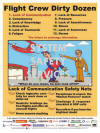
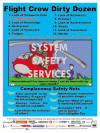
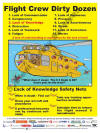
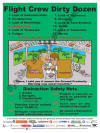
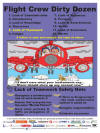
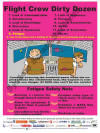
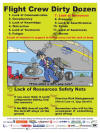
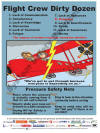
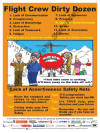
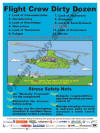
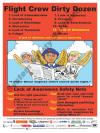
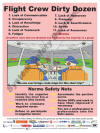
We Thank the Sponsors for their
Support.
Order Form

 Our
Mission: "To assist our clients in developing the best possible
Safety System to meet their needs".
Our
Mission: "To assist our clients in developing the best possible
Safety System to meet their needs".